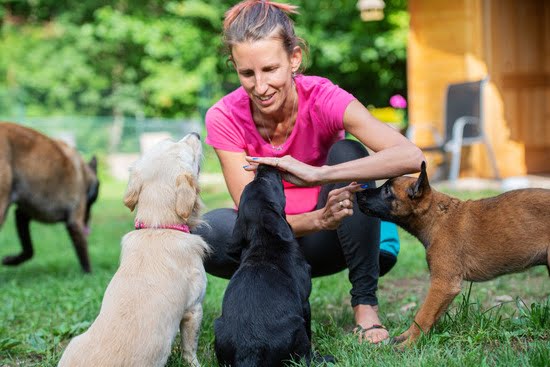Introduction
Service dogs are very special animals that have been specially trained to help those with disabilities. Service dogs provide emotional and physical assistance, making life easier and more manageable for those with disabilities. Typical tasks they perform include; supporting individuals when walking, picking up dropped items, and assisting in medical-related tasks such as alerting their handler of seizures or reminding them to take medication. They can also help people with psychiatric disabilities by providing a calming presence during episodes of depression or anxiety. In general, service dogs can offer security, independence and companionship.
The process of getting your dog trained as a service dog may be lengthy and challenging as it requires completing certain tests and obtaining certain certifications; however, there are many resources available to assist you on the journey. Many organizations offer training programs for potential service dogs. These programs typically involve trainers assessing the pup’s abilities, observing its temperament, teaching obedience commands and introducing the animal to positive reinforcement methods. Usually several months are spent in households for these pups to be exposed to different environments prior to continued public access training which is an important component in becoming certified as a service dog. If successful, the animal will then receive official certification from an accredited organization after its performance has been tested against national standards. It is recommended you find a reputable program with well qualified trainers who understand your pet’s strengths, personality traits and any additional needs they may have before choosing a specific program or community organization to train your service dog.
What is a Service Dog?
A Service Dog is a highly trained assistance dog that is specifically trained to perform life-enhancing tasks for individuals with disabilities. These dogs are skilled in helping mitigate the effects of disabling conditions including PTSD, physical limitations, and hearing and vision impairment. A Service Dog can help its handler achieve greater independence and adjust to life with a disability. As an example, a Service Dog may be trained to alert a hearing-impaired person when someone is knocking at their door or when a smoke alarm has gone off. They may also be trained to provide physical stability and assistance with mobility tasks such as retrieving objects, opening doors, and providing balance support. Furthermore, they can be taught specialized commands related to their handler’s individual disability, such as blocking strangers from entering personal space for those living with anxiety disorders. The bond between the service dog and its handler is an incredible thing to watch and many people report feeling more secure and confident having this animal by their side at all times.
Advantages and Disadvantages of Having a Service Dog
Advantages of having a service dog:
1. Having an animal companion to help with daily tasks and provide emotional support.
2. Having someone to help relieve anxiety and stress in overwhelming situations.
3. Improved mobility and independence with specially trained dogs that can assist you with your day-to-day activities such as hoisting, retrieving items, providing balance support, and opening doors.
4. Increased access to public locations, such as restaurants, airports, museums and stores that may not be accessible without an assistance animal present.
5. Increasing sociability through increased interactions due to having a service dog present in social settings or among friends and family members.
Disadvantages of Having a Service Dog:
1. Spending time researching different types of service animals and their training methods before committing to having one in your home.
2. Investing time into obedience training for the animal in order for them to do their job correctly and reliably each time they are called upon to assist you with something.
3. Costs associated with maintaining the health and well-being of the animal including vet visits, food, grooming equipment etc,.
4. Having to bring the animal along wherever you go which can make it difficult to travel or attach them in public locations while still adhering to safety regulations regarding service animals on the premises..
Determining if a Service Dog is Right for You
If you are considering getting your dog trained as a service dog, you should first look at whether this is the right decision for you. Think about your lifestyle and needs; this will help you determine whether or not having a service dog is right for you. Some of the questions that you may want to ask yourself include: Do I feel safe in my own home? Do I experience emotional difficulty in public settings? Would I benefit from increased mobility while going out and about with my dog? Additionally, consider whether your current schedule, home environment, energy level, and finances can accommodate a service dog. All of these things need to be taken into account before making this decision. Once you have determined that it is the right fit for you, research the type of service training that is best suited for both you and your canine companion. Finally, contact a reputable organization that offers suitable training options aligned with standards recognized by Assistance Dogs International (ADI).
Finding the Right Dog for Service Training
The first step in getting your dog trained as a service dog is to make sure you find the right one for the job. It is important to research which breeds are best suited to serve as assistance dogs and look for a pup that is confident, has no aggressive tendencies, and is mentally and physically sound. In some cases, people may already have an adult-aged dog they would like to train and this is possible, but it usually requires more effort due to the fact that they may not easily accept new commands or adapt quickly. It is essential to partner with an experienced professional who specializes in service animal training so they can help you determine if the pup or adult-aged dog has the necessary characteristics needed for successful service training. Additionally, when working with a trainer, have them evaluate the pup or adult before beginning any formalized programming so you can be sure that their physical needs are met throughout the process. Doing so will ensure that your pup or adult has all of the best chances for development into a successful service animal.
Starting the Training Process
Starting the process of training a service dog can be an intimidating prospect. There are two main ways to begin: doing it yourself at home or seeking professional help.
If you decide to train your dog at home, carefully research parts of the process before beginning and only start when both you and your pup are prepared. Develop a training program centered on the tasks your dog must know to qualify as a service dog, such as learning to sit, stay and heel. Obedience classes can also teach basic commands that help create a bond between pet and owner, but don’t forget about safety skills either. Ensure your service pup knows how to look for cars or other hazards in public environments.
Alternatively, you can take classes with a professional trainer or organization who specializes in teaching service dogs. They will have access to resources, knowledge and equipment that may not be available in your home. Trainers often focus on developing obedience, safety behaviors and socialization skills specifically tailored to serving people with disabilities. Professional trainers may also charge substantially more than at-home sessions do but provide invaluable instruction that many find well worth the extra funds.
What Commands Do Service Dogs Typically Need to Know?
Service dogs need to be highly trained in order to reliably help their handlers. Generally, they must follow several basic commands, including “sit,” “down,” “heel,” and “stay.” In addition, service dogs should understand the following specific commands:
-“Go to your spot” – this command instructs the service dog to retreat away from a specific situation or person.
-“Target/touch” – this command teaches the service dog to direct focus on an object, such as a door handle or a light switch.
-“Back up/give space” – this command teaches the service dog to provide physical space between their handler and any other person or animal.
-“Leave it/drop it” – this command instructs the service dog not to take food off of surfaces, steal items from others, or engage with dangerous or distracting objects.
– “Bark once/alert” – this command creates an alerting system that can help alert handlers of potentially dangerous situations and people approaching.
Rules and Safety Tips for Taking a Service Dog Out in Public
If you have been approved to have a service dog, here are some important safety tips and rules for taking your canine companion out in public when you need assistance.
First, always remember that service dogs are considered working animals, so they should wear an appropriate vest or coat when out in public that identifies them as such. This is not only for your comfort and the safety of other people but also to ward off any potentially enabling behavior from onlookers who may attempt to pet your dog or interfere with his work.
Second, it is essential that your service dog be well-behaved when out in public. Make sure their training is up-to-date and they respect the commands given by their handler. Have plenty of treats available as positive reinforcement if needed — this will ensure they stay focused on their task at hand and will help keep him safe and healthy.
Third, limit distractions while in public. If there are lots of pedestrians or other activity going on nearby, it can stress or distract your service dog and impede their focus on providing assistance to you. Keep any commands simple and clear while keeping noise and movement around the animal minimal where possible.
Finally, always remember that it’s against the law for anyone to ask you intrusive questions about why you need a service animal, what disabilities you might have or request proof of medical certification for the dog being brought into a store or other place of business. For more information about how to handle encounters like these should they occur, contact a local lawyer who specializes in disability rights law for guidance.
Benefits of Having Your Dog Certified as a Service Dog
Having your dog certified as a service dog can be an incredibly rewarding experience. Not only will you be providing your loyal companion with a meaningful job, but they will also experience tremendous benefits from the training process. Certified service dogs are particularly well suited to provide support and assistance to their owners in countless ways. Service dogs can offer physical, emotional and psychological support. They can assist with daily tasks such as managing medication schedules, or remind owners when it is time to take breaks in order to reduce stress and prevent exhaustion. Additionally, individuals with physical disabilities may rely on a service dog for balance, guidance and help with ambulation or mobilization. Service dogs may also provide someone feeling overwhelmed or anxious with calming comfort and reassurance throughout their day-to-day activities. Ultimately, having a service dog is an amazing way to provide secure companionship in times of need.
Conclusion
Training a service dog is essential to ensure that they are able to safely and effectively help their assigned handler. Properly trained service dogs must have the ability to recognize and respond quickly to a variety of commands, in addition to being able to remain calm and focused at all times. This type of training often begins from puppyhood throughout adulthood and requires both consistency and patience on the part of the handler.
The importance of proper training for service dogs cannot be overstated. Service dogs need to be able to navigate public places and interact with other people, animals, and objects appropriately. They need to possess excellent skills in recognizing dangerous situations and responding appropriately in order to keep their handler safe. Depending on the specific tasks needed for their handler, service dogs may also need additional advanced obedience or scent work training so that they can effectively perform more complex tasks related to that person’s disabilities or health condition. All forms of proper training will allow a service animal to provide ongoing assistance and comfort while ensuring the safety of their assigned handler under any circumstance.

Welcome to the blog! I am a professional dog trainer and have been working with dogs for many years. In this blog, I will be discussing various topics related to dog training, including tips, tricks, and advice. I hope you find this information helpful and informative. Thanks for reading!





